Appendix A: Component Software Architecture
1 Introduction
We outline the design of a component-based software architecture that analyses and val-
ues industrial investment projects. We use the contingent claim, or real option, valuation
method, which views a project as a claim to future cash flows which are dependent on un-
derlying stochastic factors, such as the market price of a produced commodity. The software
architecture enables the user to use domain and mathematical level constructs to specify
the nature of the project and the stochastic behaviour of underlying factors. Meaning pre-
serving symbolic rewrite rules transform these specifications into problem representations
that are suitable for numerical solution. The transformed problem representations are then
combined with components implementing parallel algorithms in order to compute solutions.
The aim of this approach is to benefit strategic industrial decision-making by enabling
high-level and flexible problem formulation and by using high performance computational
resources.
Figure 1: Component overview.
2 Component Design
The design of the software architecture aims to facilitate rapid development of transparent
investment project valuation programs delivering real time results using advanced hardware,
algorithms and software techniques. This can be achieved by allowing users to specify
models naturally and easily at the mathematical level and by using symbolic rewrite rules
and component technology to construct solution code.
1
�
In order to structure solution code we generate components representing views of the
problem at different levels of abstraction: the domain level, the model level and the numer-
ical level. These are combined using software -mechanisms of inheritance and composition
to produce the final computational component, which actually computes the solution. Such
an approach aims to retain high level information and facilitate component re-use and hence
problem reformulation.
3 Domain Level Component
The basis for valuing investment projects are the streams of uncertain cash flows the project
produces. A symbolic language specifies investment projects and underlying factor models.
This comprises equations specifying cash flows contingent on system variables and stochas-
tic equations modelling system variables. The basic equation defining the project is the
profit function simply defined as revenue minus costs. For a specific project the individual
components of revenue and costs are specified.
Thus at the domain level the user specifies the project in terms of its contingent cash
flows. These define the profit function, which is a function of time, the decision variables
of the project management, and the random underlying factors. This specification can be
made using structured text, such as XML. Alternatively the specification could be made
using a symbolic programming language such as Mathematica or Maple, which would fa-
cilitate the symbolic transformations described below. In either case the specification can
then be automatically processed to construct a C++ component representing the project.
This enables its reuse in the specification of future problems and provides a (domain-level)
symbolic name for its structure.
These components define projects abstractly by defining the types’ permitted opera-
tions; thus they provide an external interface to the computational derivative components
which are subtypes. This facilitates polymorphism so that model and numerical components
can be modified without disruption to client applications.
Each component has as its data members the specified decision variables, the random
underlying factors and as member function the profit function. Note that at this point we
have not yet defined the stochastic behaviour. This is because often the user may wish
to try out various different stochastic models, and over time may change his or her view
of which model is most appropriate. The domain level C++ component is independent of
model, and thus need not change when the model or its numerical implementation changes.
4 Model Level Component
Any realistic model of an industrial project involves uncertainties. For example, the future
demand of a commodity, the price of raw materials, government policy on pollution, all are
to a greater or lesser extent unknown. These factors which are uncertain are modelled as
stochastic factors.
The dynamics of the stochastic factors are specified as stochastic processes. These can
be in discrete time or in continuous time, in which case they can be specified as stochastic
differential equations (SDEs) which allow the specification of very general stochastic pro-
cesses and admit a simple intuitive interpretation: The movement over time of the process
is composed of two parts: a deterministic drift and a random diffusion, which is driven by
a standard Brownian motion. We employ symbolic programming language to specify such
2
�
SDEs as triples of the form: name,drift,diffusion.
Once the model is represented in this way we can apply symbolic transformations written
in the symbolic language. For example we have writtten a symbolic analytical solver for
simple SDEs (linear or reducible to linear form). Further symbolic transformations encode
results from stochastic analysis, such as:
1. the Ito formula, which gives the SDE for a functional of an SDE
2. Girsanov’s theorem, which gives the SDE for a process under a change of probability
measure (which is fundamental to contingent claim theory).
3. The differential generator of an SDE, which is a partial differentail operator which
can be used to contruct related partial differential equations, such as Kolmogorov’s
equations and contingnent claim pricing equations such as Black-Scholes type equa-
tions
In short the model component contains the specification of the dynamics of relevant stochas-
tic factors , and also further information derived from the specifications using symbolic
transformations. This information is held in the symbolic programming language file, and
also can be translated into a C++ model component.
5 Symbolic Transformations and Problem Representation
The domain level and model level components together give a software representation of the
mathematical problem definition, which is in general a stochastic control problem. Further
symbolic transformations can be applied to simplify or reformulate this representation.
For example we can encode the algebraic properties of the expectation operator, such as
linearity and idempotency, as rewrite rules. Such rewrite rules take the form of:
⇒ aE[X]
E[aX]
E[X + Y ] ⇒ E[X] + E[X]
E[E[X]] ⇒ E[X]
Applying these rewrite rules to the symbolic software representation of the mathematical
problem, we can derive expressions for the mean, variance and higher-order moments of the
objective function. Since these expressions can become very complicated, this automatic
derivation eliminates possibilities of human error.
The advantage of using symbolic transformations of specifications to provide different
representations is that the meaning of the program is given by the specification and is
preserved by the transformations. However, efficient implementation is achieved by using
pre-existing components for the implementation of numerical solution. Thus this approach
utilises separation of program meaning and program implementation which potentially can
facilitate a high level programming approach with efficient implementation.
6 Numerical Level Component
Algorithms that solve the types of problems encountered are encapsulated in numerical
components. We plan to re-use or repackage existing algorithmic code, or to write new
numerical components for novel algorithms.
3
�
Since the general stochastic control problem can be represented in various ways, de-
pending on the properties of the specific problem, there exists a wide variety of numerical
methods that can be used to solve the differing representations.
When posed in continuous time the stochastic control problem can often be stated more
explicitly as a non-linear Hamilton-Jacobi-Bellman equation. Such a representation can be
solved using finite difference or spectral methods. Explicit finite difference methods can
be effectively parallelised by decomposing the spatial domain and using a halo for local
boundary communication. However the stability conditions can be very restrictive on the
relative sizes of time and spatial steps. Implicit finite difference methods involve the solution
of a matix equation at each step and there exist many effective ways to parallelise direct
or iterative solutions.
When decision boundaries can be computed a priori, for example when the stochastic
control problem involves only open loop controls (see Intriligator), simulation methods can
be used to compute solutions. By their nature Monte Carlo simulation methods parallelise
very easily and effectively. When this is not the case i.e. when the optimal decisions are
functions of time and the state variables and must be computed along with the overall
solution (closed loop controls), dynamic programming methods are useful. For details of
initial implementation of parallel dynamic programming methods on a lattice see Tsang.
Finally in some cases the stochastic control problem can be transformed into a deter-
ministic control or optimistation problem. Then methods such as dynamic programming,
the simplex method, and Newtonian methods can be utilised.
We have constructed parallel algorithm components suited to the solution of the contin-
gent claims problems by writing Single Program Multiple Data parallel code using MPI and
using SPRNG for parallel random number generation. In the future we intend to construct
parallel algorithm components exculsively around existing high performance libraries, such
as SPRNG and SCALAPACK.
7 Computational Component
A computational component that actually solves the problem is constructed by combining
information from the domain level and model level components with numerical compo-
nents. The object-oriented mechanism of class inheritance and composition can facilitate
this combining of information: the computational component can inherit from both the
domain level and model level component in order to contain the project profit function
and symbolically derived model information, such as analytical SDE solutions and alter-
native mathematical problem definitions. The numerical component appropriate to the
representation symbolically derived in the model component can then be called, taking as
a parameter the relevant information from the domain and model level components.
Such a software design aims to facilitate the rapid construction of programs using alter-
native algorithms by re-using existing domain level and model level components. A similar
software architecture was successfully applied to financial option problems in Automatic
Generation of Software Components for Financial Modelling [Bunnin].
References
[1] Blackford L.S, J. Choi, A. Cleary, E. D’Azevedo, J. Demmel, I. Dhillon, J. Dongarra, S.
Hammarling, G. Henry, A. Petitet, K. Stanley, D. Walker, R. C. Whaley, ScaLAPACK
4
�
User’s Guide http://netlib2.cs.utk.edu/scalapack/slug/scalapack slug.html 1997.
[2] Cyganowski S., A Maple package for Stochastic Differential Equations, in Compu-
tational Techniques ans Applications 1996 eds A. Easton, R. May Singapore World
Scientific.
[3] Cyganowski
S.,
Solving
Stochastic Differential Equations with Maple,
http://net.indra.com/ sullivan/q253.html.
[4] Darlington J., Guo Y., To H.W., Yang J., Functional Skeletons for Parallel Coordi-
nation, in Haridi S., Ali K, Magnusson P. eds Proceedings of Europar 95, Springer
August 1995.
[5] Intriligator M.D., Mathematical Optimisation and Economic Theory, Prentice Hall
1971.
[6] Kant E., C. Randall, A. Chhabra, Using Program Synthesis to Price Derivatives,
Journal of Computational Finance vol. 1 no. 2 (Winter 1997/98) 97-129.
[7] Tsang Mang Kin, Frdrick, Using Multiprocessors for Pricing American Options, MSc
thesis, Dept. of Computing, Imperial College 2000.
5
�
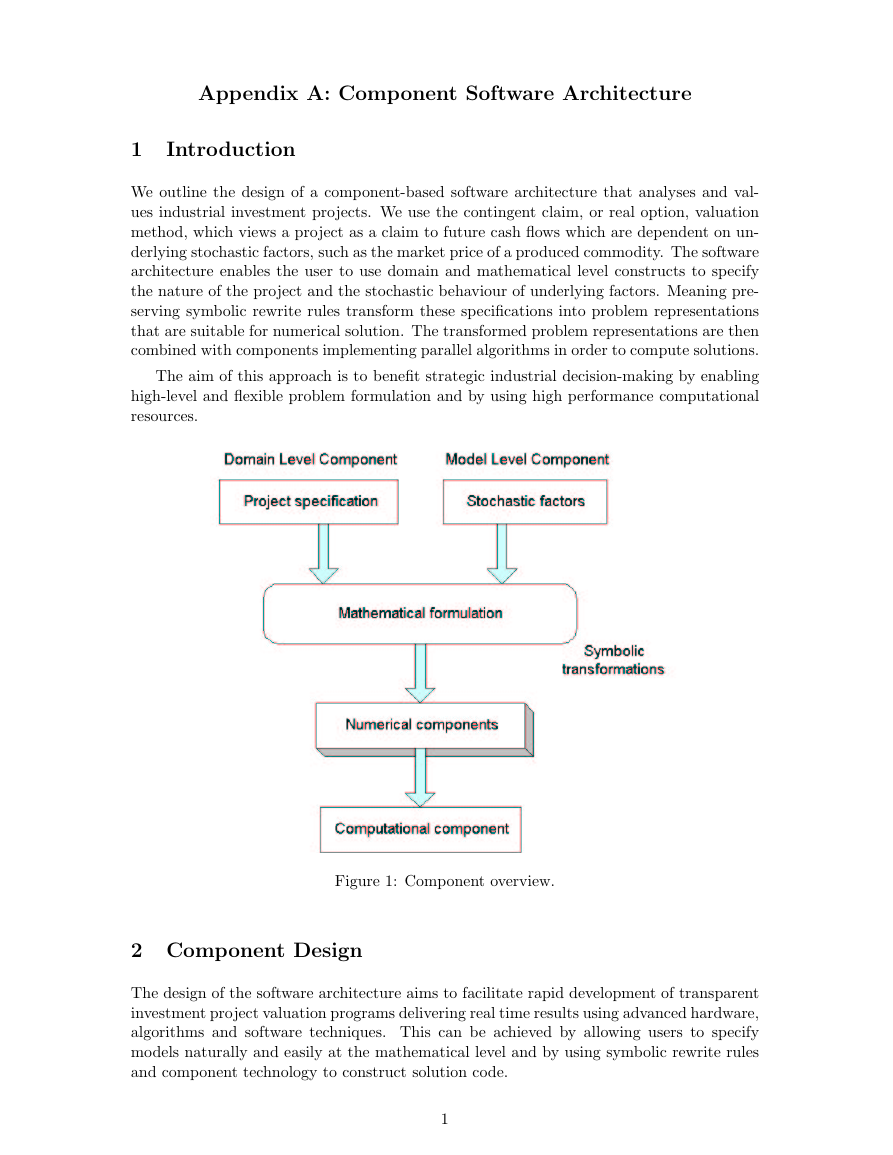
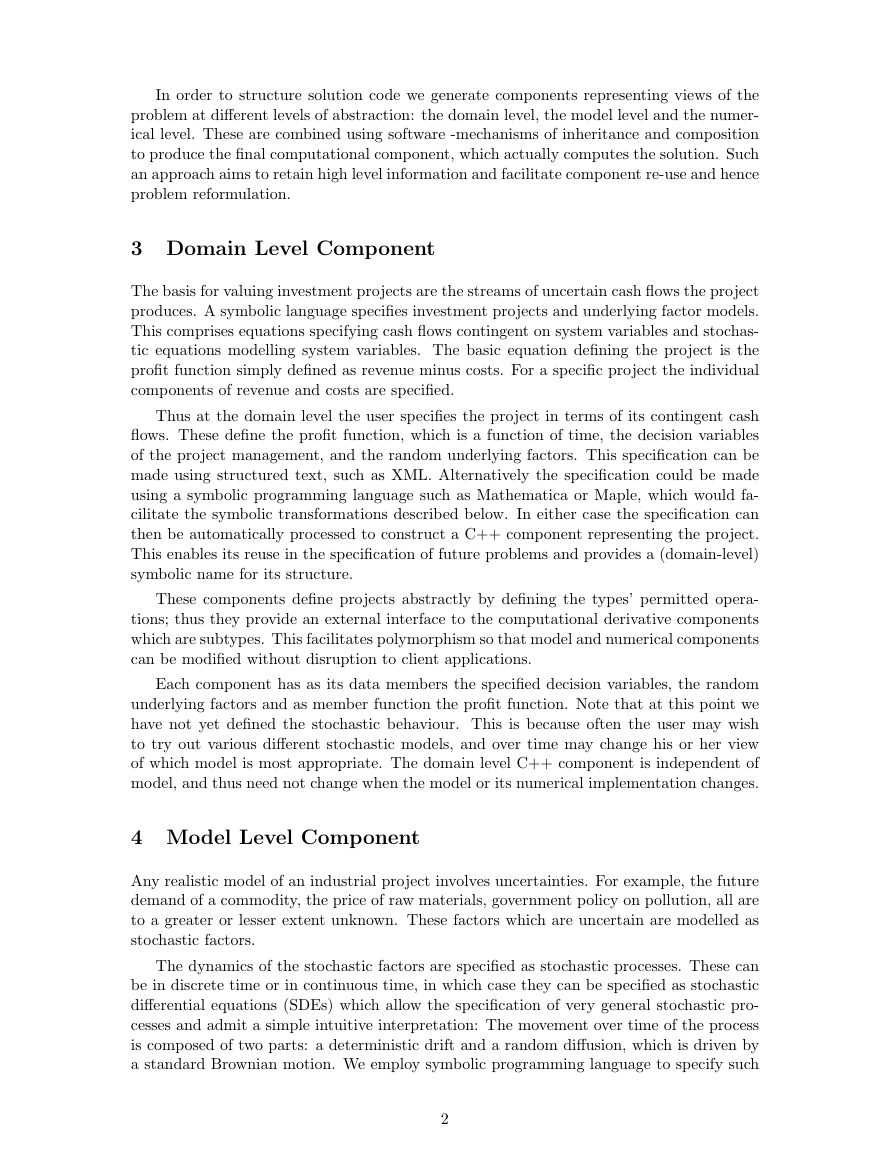
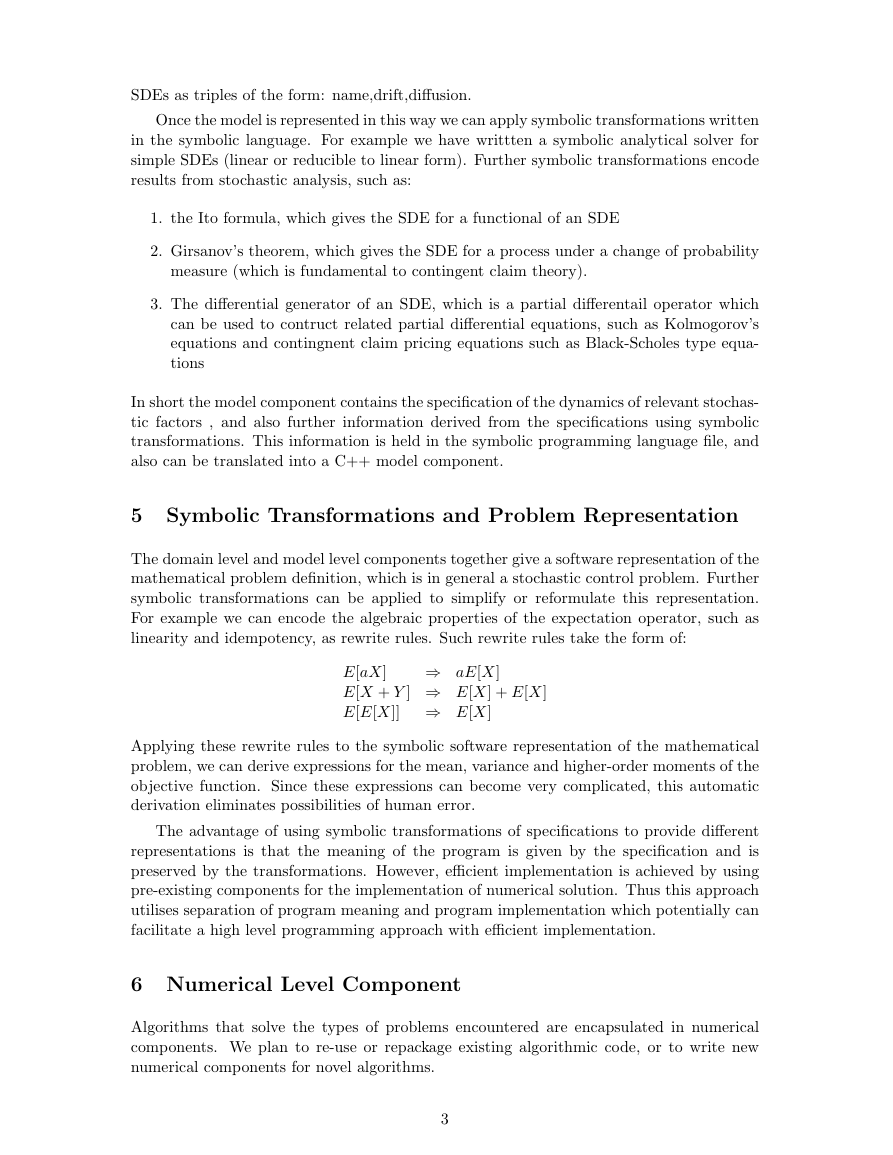
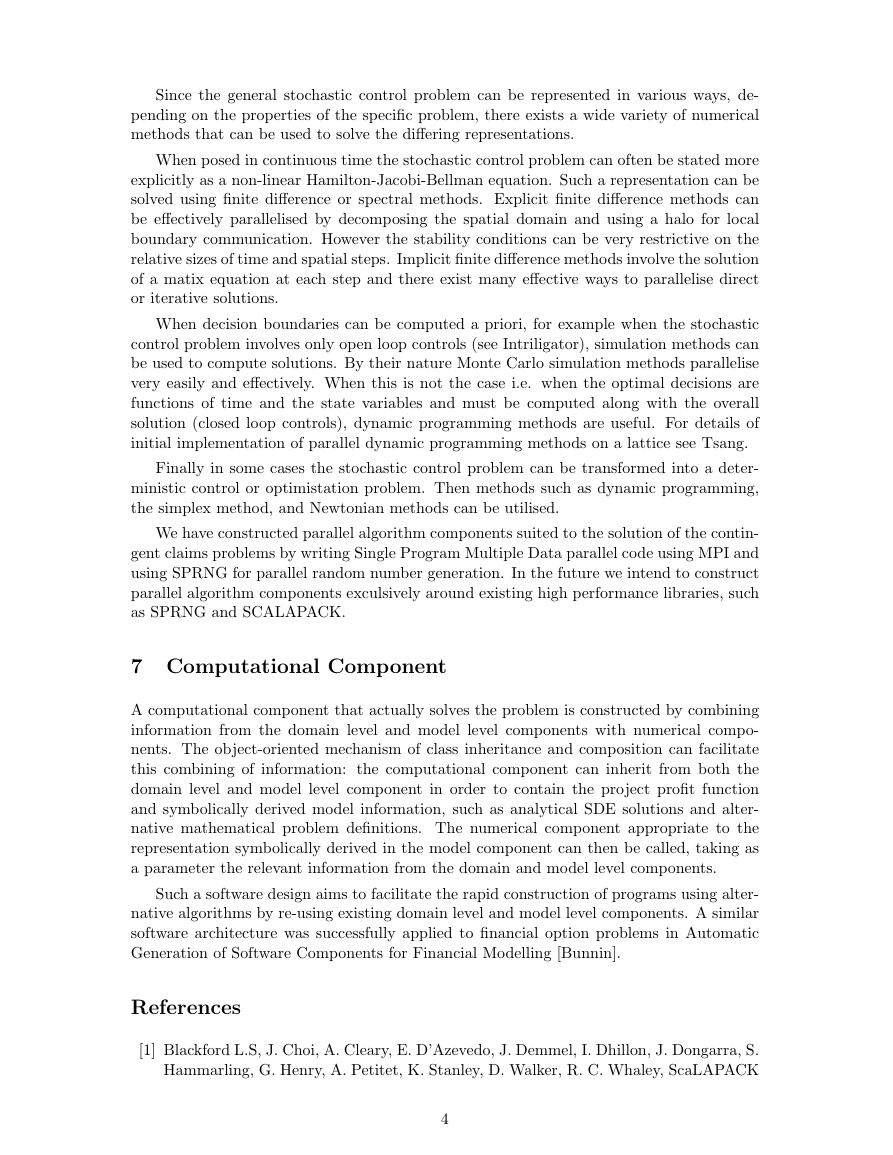
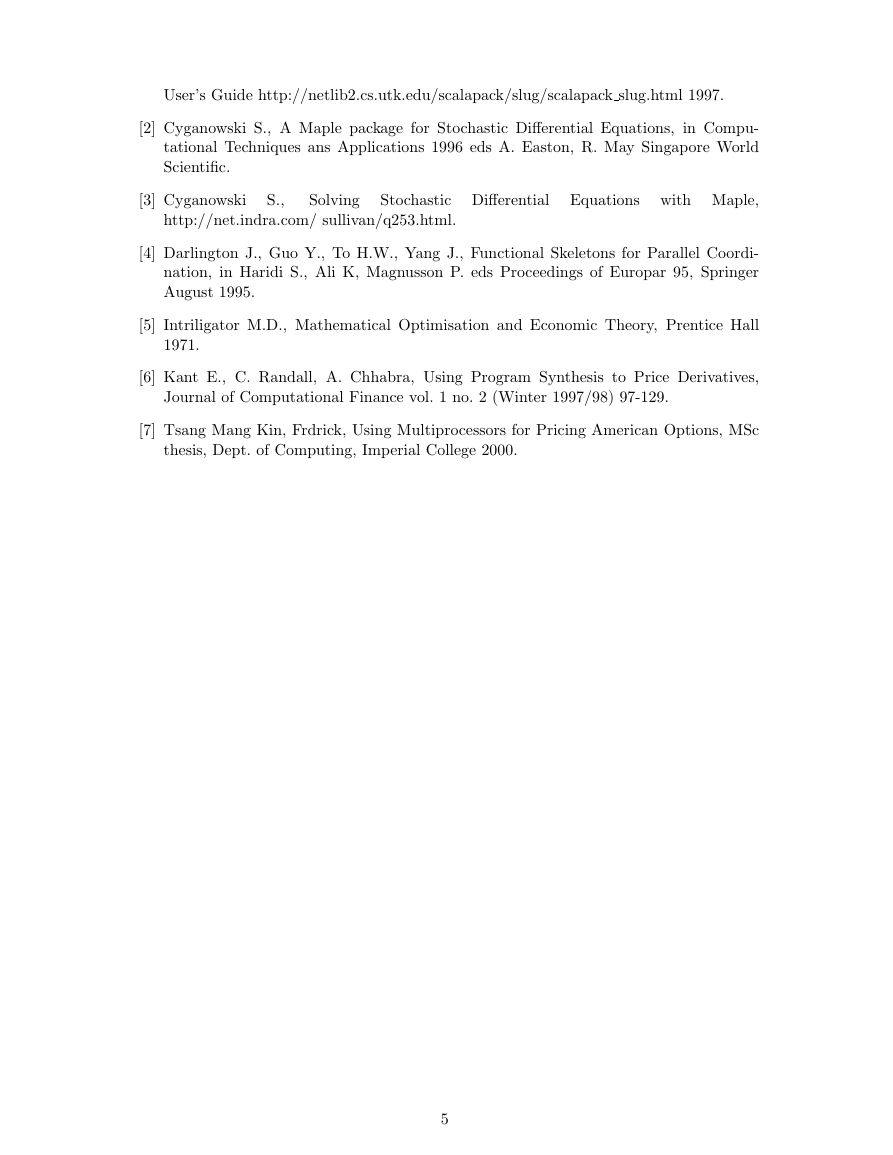





 2023年江西萍乡中考道德与法治真题及答案.doc
2023年江西萍乡中考道德与法治真题及答案.doc 2012年重庆南川中考生物真题及答案.doc
2012年重庆南川中考生物真题及答案.doc 2013年江西师范大学地理学综合及文艺理论基础考研真题.doc
2013年江西师范大学地理学综合及文艺理论基础考研真题.doc 2020年四川甘孜小升初语文真题及答案I卷.doc
2020年四川甘孜小升初语文真题及答案I卷.doc 2020年注册岩土工程师专业基础考试真题及答案.doc
2020年注册岩土工程师专业基础考试真题及答案.doc 2023-2024学年福建省厦门市九年级上学期数学月考试题及答案.doc
2023-2024学年福建省厦门市九年级上学期数学月考试题及答案.doc 2021-2022学年辽宁省沈阳市大东区九年级上学期语文期末试题及答案.doc
2021-2022学年辽宁省沈阳市大东区九年级上学期语文期末试题及答案.doc 2022-2023学年北京东城区初三第一学期物理期末试卷及答案.doc
2022-2023学年北京东城区初三第一学期物理期末试卷及答案.doc 2018上半年江西教师资格初中地理学科知识与教学能力真题及答案.doc
2018上半年江西教师资格初中地理学科知识与教学能力真题及答案.doc 2012年河北国家公务员申论考试真题及答案-省级.doc
2012年河北国家公务员申论考试真题及答案-省级.doc 2020-2021学年江苏省扬州市江都区邵樊片九年级上学期数学第一次质量检测试题及答案.doc
2020-2021学年江苏省扬州市江都区邵樊片九年级上学期数学第一次质量检测试题及答案.doc 2022下半年黑龙江教师资格证中学综合素质真题及答案.doc
2022下半年黑龙江教师资格证中学综合素质真题及答案.doc